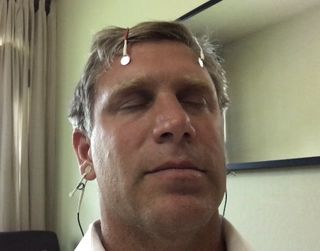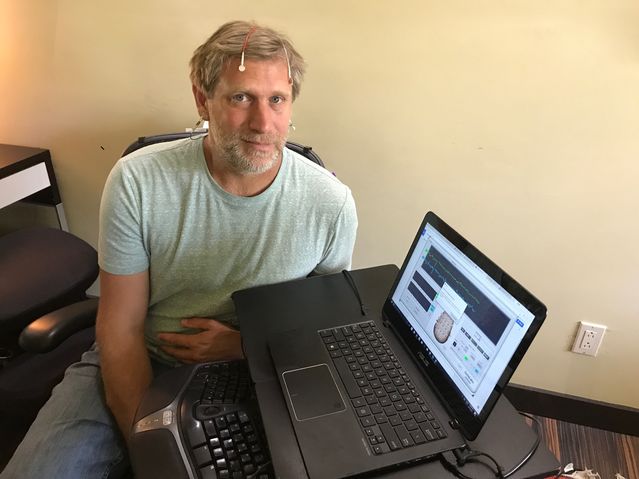
Addiction
I Tried Direct Neurofeedback and the Results Surprised Me
An interview with direct neurofeedback specialist Grant Rudolph.
Posted March 13, 2018 Reviewed by Jessica Schrader
Transhumanism—the movement of using science and technology to improve the human being—covers many different fields of research. There are exoskeleton suits to help the disabled; there are stem cell treatments to cure disease; there are robots and AI to perform human chores. The field is wide open and booming as humanity uses more and more tech in its world.
It’s not that often I get to participate directly in these radical technologies, but I did so recently when Grant Rudolph, clinical director at Echo Rock Neurotherapy in Mill Valley, California, invited me to try his direct neurofeedback techniques. Via his computer and EEG wire hookups, Rudolph echoed my brainwave information back into my head at an imperceptible level. I did two sessions of direct neurofeedback.
At first, I was skeptical that I’d even feel anything since the EEG information can’t be detected by the skin as a sensation, but within five minutes of having the wires stuck onto my forehead, I began feeling different. I can compare it to a light dose of a recreational drug: I felt happy, content, and worry-free. I also felt more introspective than normal. The feedback only took a few seconds, and after about 15 minutes, I seemed to notice the world’s colors were sharper and my hearing was more acute. The heightened awareness and calming effect lasted about 24 hours and then most of it gradually wore off. Some of the clarity must still be working, because getting things done sometimes still seems easier. I'm told that continued sessions would make this state of clarity my new norm.

I wanted to share my experience with my readers. Here’s a short interview with Grant Rudolph to explain more about direct neurofeedback:
Q. What do most people notice from direct neurofeedback?
A. Direct neurofeedback (LENS) shows the brain how to stop worrying and be fully present in this moment. Victoria Vogel and I have given about 20,000 sessions at Echo Rock Neurotherapy, and the first words we hear clients say are usually “relaxed, calm or clear.” The immediate experience for almost everyone is an unusual deep relaxation and simultaneous bright clarity of mind. When this state keeps going for days, they eventually talk about their new traits of steady happiness, increased energy, confidence, clear boundaries, better sleep, work efficiency, and ongoing contentment.
Q. How does it work?
A. Direct neurofeedback allows people to let go of stress by showing the survival brain how it is wasting energy worrying about the past. Because our brains are very interested in energy-efficiency, they quickly abandon unskillful defensive thought-patterns once they “see” them. Direct neurofeedback supplies the missing information. Unlike biofeedback and traditional neurofeedback where the “seeing” happens with the cognitive mind, direct neurofeedback information returns transcranially through the EEG sensor wires, bypassing the cognitive process altogether. Change is easy because the wise brain simply knows what to do and makes the adjustments without effort.
Q. What conditions does it treat?
A. Direct neurofeedback clears the underlying causes of stress rather than chasing after symptoms. Therefore it is safe and effective in addressing all sorts of conditions. It has shown itself clinically successful in treating depression and fatigue, anxiety, ADHD, memory loss, PTSD, learning disabilities & autism, procrastination, head trauma, migraines, addiction, pain and much more. It can be highly effective with treatment-resistant seizure disorders and compulsive behavior. For people without a diagnosis, it enhances performance, efficiency and meditation progress. We are offering a neurofeedback enhanced meditation retreat November 24-26 this year.

Q. Who does it work for?
A. Individuals of all ages can benefit from direct neurofeedback. At Echo Rock Neruotherapy, we help super-achievers—CEOs, Olympic athletes, musicians and the like—to find their flow state and achieve peak performance. Because it is so fast and easy to administer, direct neurofeedback has been extremely effective at treating children who are on the ADHD/autism spectrum, or have behavioral, learning or attachment problems, even if they are not actively participating in the treatment. For those struggling with relationship issues, direct neurofeedback can break old patterns, allowing the love between two people to bloom.
Q. What about medications and addictions?
A. As the brain becomes more spacious, organized, and better able to effectively utilize input, clients may find themselves less in need of medication. It is important, of course, to work with a medical professional like our in-house psychiatrist to taper down medications and determine the new ideal dosage.
Clients who struggle with addiction often feel so much better after a few sessions that it becomes easy to let go of their substance of choice. Withdrawal from opiates and even benzodiazepines can be considerably smoother with direct neurofeedback. When the brain is clear, clients typically find themselves naturally making wiser choices about how to best take care of themselves.
Q. How did you get started doing direct neurofeedback?
A. I was doing a practice of noticing situations where it was appropriate for me to say the words "I'm happy for you." At the same time, I wanted to help my son who had been failing at school because he fell and hit his head. He was irritable, and couldn't focus or sit still. We tried everything, until we finally gave him direct neurofeedback. For the first time in his life, he could read a book, and pass a test on what it said. Direct neurofeedback worked so dramatically, that we offered it to all our psychotherapy clients. They were able to resolve their issues easily and immediately, without talking about their past. Now we have the pleasure of helping people having a hard time with their headspace every day. After direct neurofeedback, they are relieved and grateful, and I get to say the words "I'm happy for you!"
I am a transhumanist, author of The Transhumanist Wager, and a libertarian candidate for California governor; follow me on Twitter or Facebook or visit zoltanistvan.com.




